As electric vehicles (EVs) gain traction in the automotive market, the initial concerns about their maintenance are fading.
However, one issue remains at the forefront: thermal management. Or cooling systems in electric vehicles.
Unlike conventional vehicles, where thermal management focuses on cooling the internal combustion engine, EVs require sophisticated cooling systems to manage the heat generated by their batteries, power electronics, and motors.
But why is thermal management so critical in electric vehicles, and what makes it essential for their performance and longevity? That’s exactly what we’ll explore in this article.
What Is Cooling in Electric Vehicles Exactly?
When discussing cooling in electric vehicles (EVs), we dive into something crucial yet often overlooked.
You see, while EVs are marvels of modern technology, they come with their challenges. One of the biggest is how to keep everything running cool.
Unlike conventional cars that rely on a combustion engine, which naturally produces heat, EVs run on batteries and electric motors. But here’s the catch: these batteries and motors generate heat too. This is especially true while driving at high speeds, charging quickly, or just going about your day in hot weather.
So, what exactly does cooling in EVs involve?
It’s all about maintaining the right temperature for the vehicle’s key components, primarily the battery, the motor, and the power electronics. If any of these get too hot, you’re looking at potential performance drops, reduced battery life, or in the worst case, a complete system shutdown.
It usually involves liquid coolant, fans, heat sinks, and sometimes even refrigerants, all working together to draw heat away from the sensitive parts.
In simple terms, cooling in EVs is about ensuring that the vehicle doesn’t overheat.
So, while you might not see it at work, that cooling system is doing a lot behind the scenes. Now let’s understand exactly how it works, and what types of cooling there are.
Thermal Management in EV Batteries
Battery performance, lifespan, and overall cost are closely tied to the operation of electric vehicles.
For the battery to deliver the necessary power for starting, accelerating, and efficiently capturing energy during regenerative braking, it must be kept within an optimal temperature range.
When temperatures rise above this range, the battery’s life shortens. Due to this, the vehicle’s driveability declines, and energy efficiency takes a hit. Given the significant impact temperature has on battery function, managing the battery’s thermal conditions is essential for maintaining an electric vehicle’s performance.
Methods of Cooling EV Battery
Keeping an electric vehicle’s battery cool is essential for ensuring it performs well and lasts a long time.
There are two primary ways to cool EV batteries: air cooling and liquid cooling. Let’s explore how each method works and the types of coolants involved.
Air Cooling in Electric Vehicles
Cooling with airflow uses air to regulate the battery’s temperature and comes in two types: passive and active.
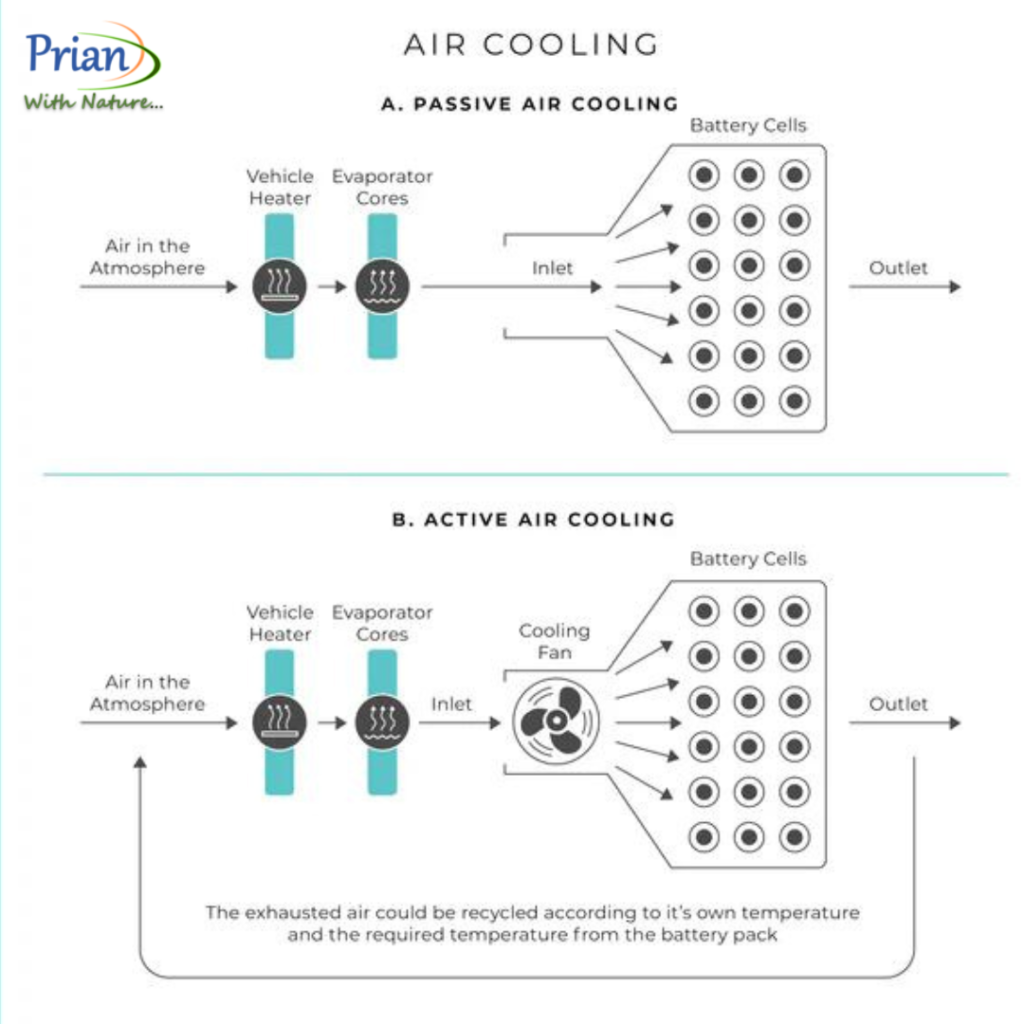
Passive Air Cooling
Passive air cooling relies on the natural flow of air from outside the vehicle or the cabin to either cool or heat the battery. This method is straightforward and doesn’t require additional equipment. But it can only handle a limited amount of heat—usually a few hundred watts. This makes it suitable for less demanding situations but less effective when more cooling is needed.
Active Air Cooling
Active air cooling, on the other hand, uses air from the vehicle’s air conditioning system. It includes components like an evaporator and a heater to control the air temperature precisely. This method can dissipate up to 1kW of heat, making it more effective for both cooling the battery and maintaining the cabin temperature. While active cooling systems are more complex and expensive, they offer better performance, especially for tasks like propulsion and fast charging. However, they do consume more energy to keep the battery at the right temperature.
The key difference between passive and active air cooling is that passive systems operate without any external devices, whereas active systems use fans, heat sinks, or even liquid coolants to manage the temperature.
Liquid Cooling in EV Batteries
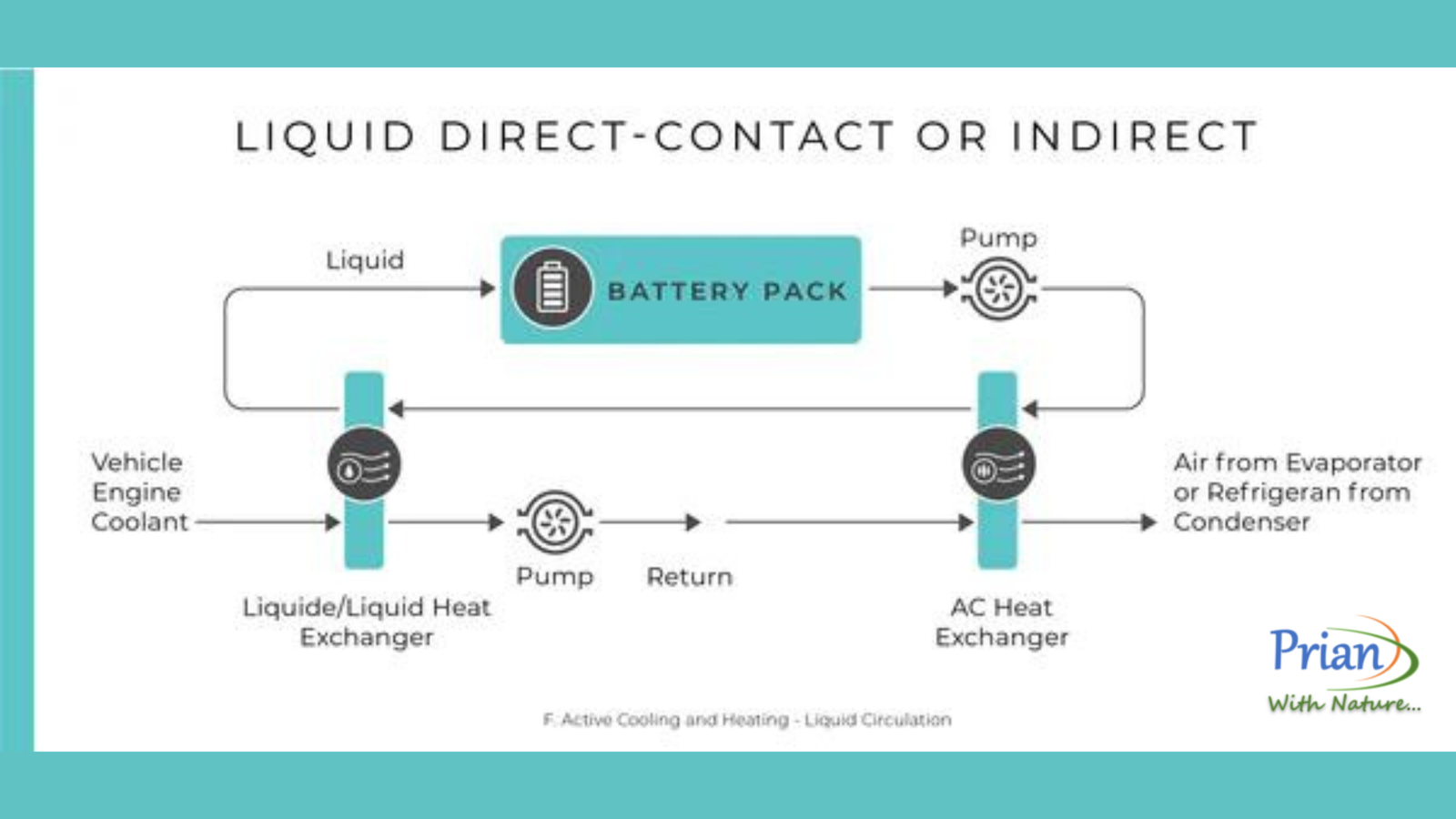
This is the most popular method for cooling EV batteries today because it’s highly efficient.
This method uses liquid coolants; such as water, refrigerant, or ethylene glycol. These flow through tubes or cold plates surrounding the battery cells. The coolant absorbs the battery’s heat and carries it to a radiator or heat exchanger.
Liquid cooling systems involve pumps, fans, and other components to move the coolant and maintain a stable temperature actively.
Some advanced systems use direct-contact coolants like oil or dielectric liquids. However, these are mostly found in specialized, non-consumer EVs because they can be less safe and provide less insulation between the battery cells and the environment.
Evolution of Cooling Methods in Electric Vehicles
Most modern EVs use liquid cooling because liquids are much better at conducting heat than air. This makes it easier to keep the battery at an optimal temperature.
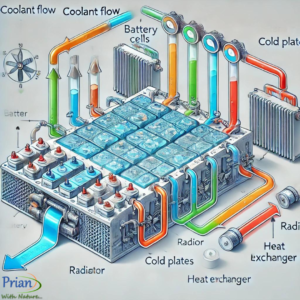
In the early days of electric vehicles, battery production was expensive. So manufacturers preferred passive air cooling to keep costs down.
However, as battery costs have decreased and the demand for fast charging has grown active liquid cooling has become more popular.
Types of Liquid Coolants Used
There are three major types of coolants are used in liquid cooling systems, each with its advantages:
- Water: Highly effective at conducting heat and readily available.
- Refrigerants: Used in systems that require phase changes to absorb more heat.
- Ethylene Glycol: Often mixed with water to lower the freezing point and prevent corrosion, making it ideal for varying temperatures.
Understanding these cooling methods helps you appreciate the engineering behind electric vehicles.
Effective thermal management not only enhances performance and efficiency but also extends the life of your EV’s battery.
Now that we know that liquid cooling is the most efficient method of cooling in electric vehicles, let’s explore the two major types of liquid cooling.
Direct & Indirect Liquid Cooling in Electric Vehicles
Direct Cooling:
Regarding direct liquid cooling systems in EVs, the coolant requirements are quite specific.
In these systems, where the battery comes into direct contact with the coolant. This is similar to fuel cell vehicles or direct liquid cooling, where the fluid needs to have low or no electrical conductivity.
This is a big contrast to the coolant used in traditional internal combustion engine (ICE) vehicles, which typically have high electrical conductivity. The reason for this is safety: since the battery is full of moving electrons, using a high-conductivity coolant could cause a short circuit, leading to potential failures, fires, or even explosions.
To keep the conductivity low, coolants might use deionized water or non-salt-based fluids. However, these types of coolants are still in the early stages of development and research.
Indirect Cooling:
Indirect liquid cooling systems in electric vehicles work similarly to the cooling systems found in conventional ICE vehicles.
In both cases, coolant flows through a network of metal pipes to transfer heat away from the battery pack or engine. Because of this similarity, the coolant used for indirect liquid cooling in EVs is the same as in ICE vehicles.
Typically, 99% of this coolant consists of substances like glycol, polyglycol, and water, while the remaining 1% is made of additives that significantly enhance engine protection and performance.
When circulating liquid coolant through metal pipes, guarding against corrosion is crucial, which can affect the vehicle’s safety and efficiency.
Metal, by its nature, is unstable and tends to react with other elements by losing electrons to achieve a more stable state. Corrosion occurs because impurities in the coolant carry a positive charge, which interacts with the metal pipes, gradually eroding their surface.
Antifreeze mixed with additive packages is used to combat this to create a coolant that prevents rust, scale buildup, and corrosion.
In ICE vehicles, these additives protect the metals found in the cooling systems, such as pipes, gaskets, connections, and radiators.
The American Society for Testing and Materials (ASTM) sets standards that coolants must meet to ensure they protect against the corrosion of different metal types. The principles of corrosion prevention used in traditional ICE vehicles can be easily applied to the indirect liquid cooling systems found in electric vehicles.
Major Challenges With Thermal Cooling in Electric Vehicles
Some of the biggest challenges in managing the temperature of EV batteries include leaks, corrosion, clogging, extreme weather, and the natural aging of the battery. Liquid cooling systems, in particular, face issues that air cooling systems generally don’t have to deal with.
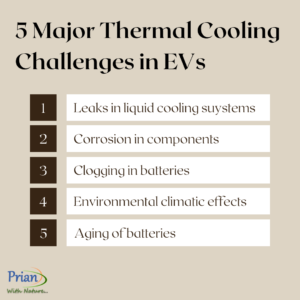
For starters, leaks are a problem unique to liquid cooling systems. As the battery ages, the connections in the cooling pipes can start to leak, which can quickly reduce battery performance and lifespan.
In some cases, leaks can even cause the EV to stop working altogether if moisture gets into the battery’s electrical insulation. That’s why it’s crucial to ensure that all battery modules, interconnections, pumps, and valves stay in good condition.
Corrosion is another issue specific to liquid cooling systems. The cold plates in these systems can corrode over time as the liquid glycol degrades. To prevent this, the cooling liquid needs to be replaced regularly as part of routine vehicle maintenance.
Then there’s the risk of clogging, which can happen in the numerous small channels that the liquid flows through within the battery.
Different climates also present unique thermal challenges. For example, leaving your car parked in direct sunlight for an extended period or living in a region with extremely cold winters can put extra strain on the battery. The cooling system must be able to handle a wide range of temperatures, even when the car is turned off.
Finally, as batteries age, they naturally become less efficient, losing more energy as heat.
This means the thermal management system needs to be designed to handle the tougher conditions that arise later in the battery’s life, not just during the early years when the battery is still in its prime.
Top 3 Cooling Systems in Electric Vehicles (Examples)
Tesla Model 3
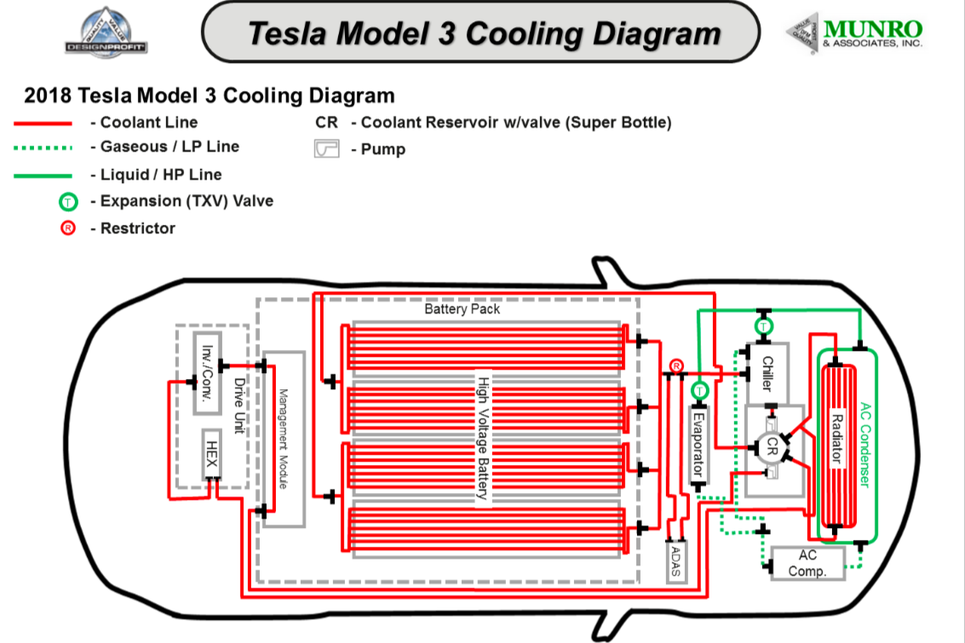
This diagram showcases the cooling system of the 2018 Tesla Model 3. The system uses a combination of coolant lines, gaseous lines, and liquid high-pressure lines to manage the vehicle’s temperature.
The high-voltage battery pack, along with the drive unit and other components, are kept cool by circulating coolant through a series of lines connected to the radiator and chiller.
The cooling system includes an expansion valve (TXV) and a restrictor to regulate the flow and pressure of the coolant. Additionally, the system is integrated with an AC compressor and condenser to ensure optimal thermal management throughout the vehicle.
This is thoroughly explained in this Jalopnik guide on Tesla’s thermal management. You can refer to that guide for more details on how this works.
This design is crucial for maintaining battery efficiency and prolonging the life of key components.
Nissan Leaf
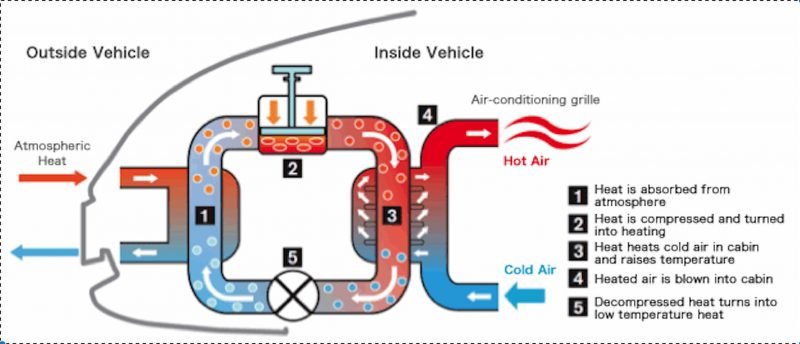
source: Donegal Daily
This diagram illustrates the cooling system used in the Nissan Leaf. Here heat is absorbed from the atmosphere and compressed to increase its temperature. This heated air is then used to warm up the cabin air. Finally, after being decompressed, the cooled air is circulated back into the cabin, ensuring temperature regulation inside the vehicle.
Chevrolet Volt
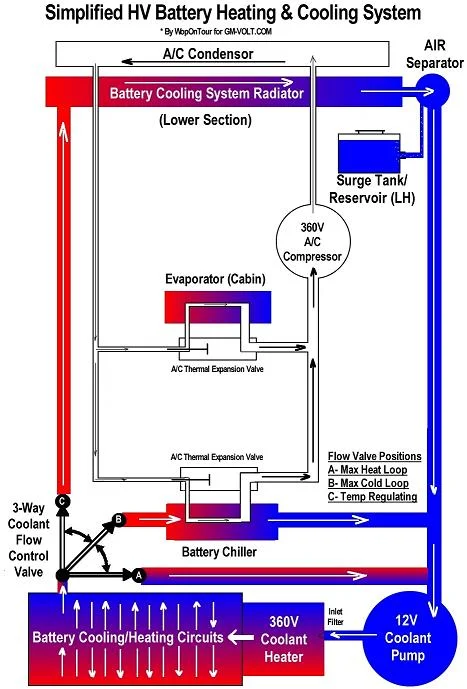
This diagram illustrates the simplified high-voltage (HV) battery heating and cooling system used in a Chevrolet Volt. The system manages the battery temperature using a combination of components, including a battery chiller, a 360V AC compressor, and a 12V coolant pump.
The coolant circulates through battery cooling and heating circuits, which are regulated by a 3-way coolant flow control valve.
The flow can be directed for maximum heating (A), maximum cooling (B), or temperature regulation (C), depending on the vehicle’s needs.
The system also includes an A/C condenser and evaporator to aid in temperature control within the cabin and the battery.
Additionally, a surge tank acts as a reservoir to maintain coolant levels, while the air separator ensures the system remains air-free for optimal efficiency.
This comprehensive thermal management system ensures the battery operates within its ideal temperature range.
Frequently Asked Questions on EV Cooling
What Is Cooling in EV Batteries?
Keeping the battery cool is all about managing its temperature in electric vehicles to maintain peak performance, extend its life, and ensure safety by getting rid of the extra heat that builds up while driving.
Why Is It Important To Cool Batteries in EVs?
It’s crucial to keep the battery cool to avoid overheating, thermal runaway, a shorter battery life, and potential safety risks. Good cooling guarantees steady performance, a longer-lasting battery, and improved safety overall.
Do All EVs Come With In-built Cooling or Thermal Management Systems?
Yes, almost all electric vehicles use some type of battery cooling, whether it’s air or liquid-based, to keep the battery at the right temperature and ensure consistent performance.
How Can I Ensure Thermal Safety For My EV?
Making sure that your battery doesn’t take too much load, is the first and the most important step.
To make sure of this, use AC chargers instead of DC chargers. In our AC vs DC charging guide, we’ve explained how exactly fast charging can damage your EV battery.
Looking for a safe, effective, and affordable EV charging station for your home?
You can check out our EV charging stations here, and make your choice for which charger to go ahead with. We’d recommend the ZULU Home EV Charging Station for the best longevity.
Book a call with us, and we’ll guide you on exactly how you can approach this!


Leave a Reply